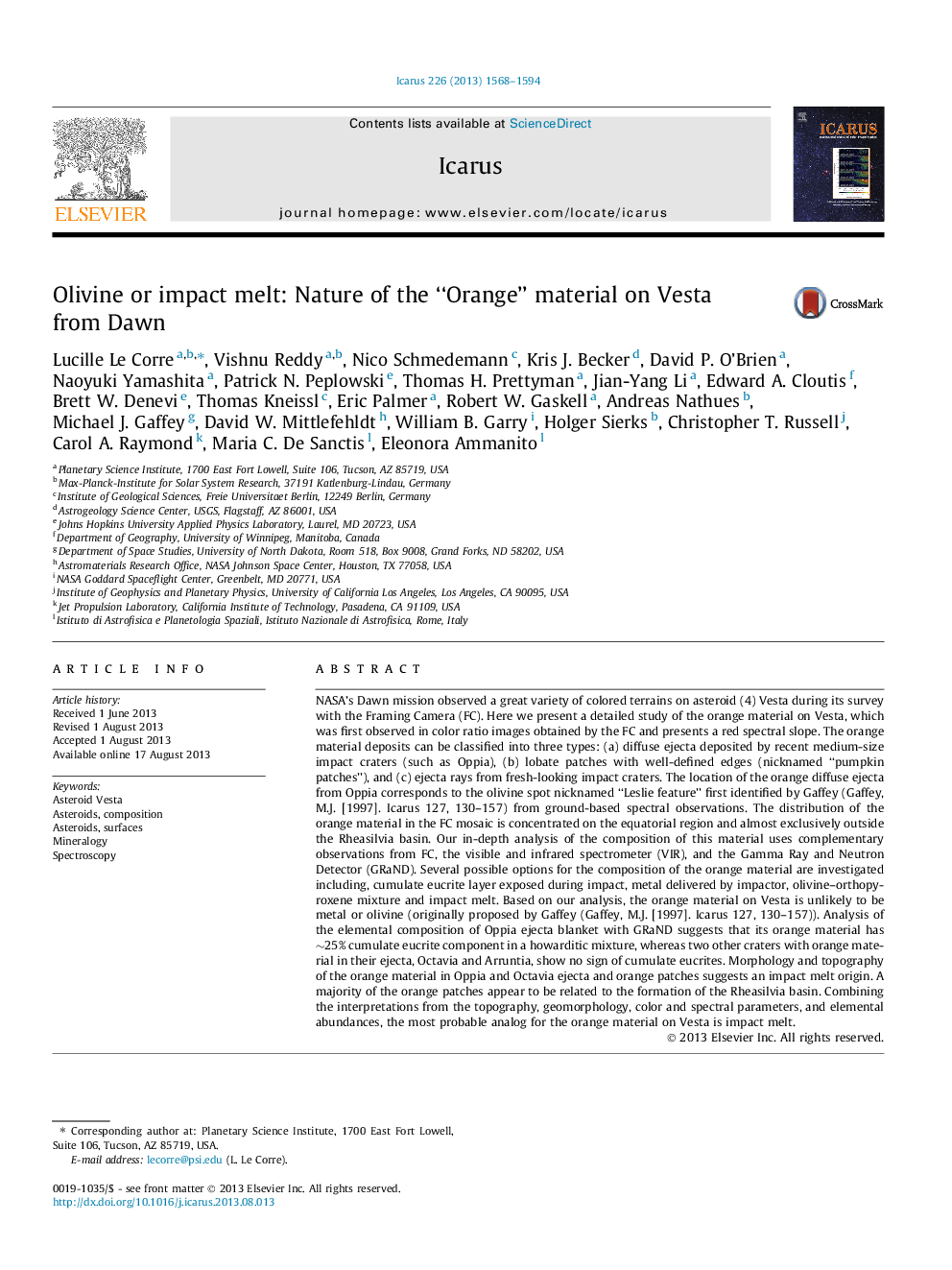| کد مقاله | کد نشریه | سال انتشار | مقاله انگلیسی | نسخه تمام متن |
|---|---|---|---|---|
| 10701401 | 1021129 | 2013 | 27 صفحه PDF | دانلود رایگان |
عنوان انگلیسی مقاله ISI
Olivine or impact melt: Nature of the “Orange” material on Vesta from Dawn
ترجمه فارسی عنوان
اولیوین یا تاثیر ذوب: طبیعت پرتقال؟ مواد در وستا از سحر
دانلود مقاله + سفارش ترجمه
دانلود مقاله ISI انگلیسی
رایگان برای ایرانیان
کلمات کلیدی
سیارک وستا، سیارک ها، ترکیب، سیارک ها، سطوح، کانی شناسی، طیف سنجی،
موضوعات مرتبط
مهندسی و علوم پایه
علوم زمین و سیارات
علوم فضا و نجوم
چکیده انگلیسی
NASA's Dawn mission observed a great variety of colored terrains on asteroid (4) Vesta during its survey with the Framing Camera (FC). Here we present a detailed study of the orange material on Vesta, which was first observed in color ratio images obtained by the FC and presents a red spectral slope. The orange material deposits can be classified into three types: (a) diffuse ejecta deposited by recent medium-size impact craters (such as Oppia), (b) lobate patches with well-defined edges (nicknamed “pumpkin patches”), and (c) ejecta rays from fresh-looking impact craters. The location of the orange diffuse ejecta from Oppia corresponds to the olivine spot nicknamed “Leslie feature” first identified by Gaffey (Gaffey, M.J. [1997]. Icarus 127, 130-157) from ground-based spectral observations. The distribution of the orange material in the FC mosaic is concentrated on the equatorial region and almost exclusively outside the Rheasilvia basin. Our in-depth analysis of the composition of this material uses complementary observations from FC, the visible and infrared spectrometer (VIR), and the Gamma Ray and Neutron Detector (GRaND). Several possible options for the composition of the orange material are investigated including, cumulate eucrite layer exposed during impact, metal delivered by impactor, olivine-orthopyroxene mixture and impact melt. Based on our analysis, the orange material on Vesta is unlikely to be metal or olivine (originally proposed by Gaffey (Gaffey, M.J. [1997]. Icarus 127, 130-157)). Analysis of the elemental composition of Oppia ejecta blanket with GRaND suggests that its orange material has â¼25% cumulate eucrite component in a howarditic mixture, whereas two other craters with orange material in their ejecta, Octavia and Arruntia, show no sign of cumulate eucrites. Morphology and topography of the orange material in Oppia and Octavia ejecta and orange patches suggests an impact melt origin. A majority of the orange patches appear to be related to the formation of the Rheasilvia basin. Combining the interpretations from the topography, geomorphology, color and spectral parameters, and elemental abundances, the most probable analog for the orange material on Vesta is impact melt.
ناشر
Database: Elsevier - ScienceDirect (ساینس دایرکت)
Journal: Icarus - Volume 226, Issue 2, NovemberâDecember 2013, Pages 1568-1594
Journal: Icarus - Volume 226, Issue 2, NovemberâDecember 2013, Pages 1568-1594
نویسندگان
Lucille Le Corre, Vishnu Reddy, Nico Schmedemann, Kris J. Becker, David P. O'Brien, Naoyuki Yamashita, Patrick N. Peplowski, Thomas H. Prettyman, Jian-Yang Li, Edward A. Cloutis, Brett W. Denevi, Thomas Kneissl, Eric Palmer, Robert W. Gaskell,
